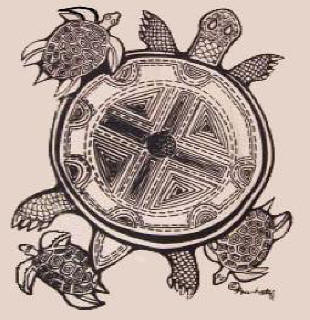 |
LITR 4231 Early American
Literature Research Posts 2014 (research post assignment) Research Post 1 |
 |
Dawn Iven
19 March 2014
Sacrificed for Being Different:
Bridget Bishop’s Story
I started my
research on why Abigail Williams began accusing people of witchcraft and what
happened to her when the Salem Witch Trials were over.
Abigail Williams was among the first young girls to accuse others of
witchcraft during the Salem Witch Trials.
While Abigail made 41 complaints, and gave testimony in seven cases, she
vanishes after her testimony on June 3, 1692. While
researching Abigail Williams, I came across Bridget Bishop; the first person
brought to trial and hanged for witchcraft during the Salem Witch Trials.
She had a colorful life and was not afraid of being different.
I was fascinated by such a unique individual and decided to find out more
about her life, why she was accused of being a witch, and why she was the first
person tried and hanged for witchcraft.
There are conflicting stories of Bridget owning two taverns in Salem.
Some believe it was actually Sarah Bishop, not Bridget, who owned the
illegal taverns in town. “The Joseph
Toronto (Guiseppe Taranto) Foundation” website states, “We
owe a great debt to David Greene, who unearthed the errors in Bridget’s history
and published his findings in 1981 in The American Genealogist”
(Morrell).
The town of Salem still maintains that Bridget Bishop was the owner of
the taverns. In the performance of
Cry Innocent, a History Alive
reenactment of Bridget’s 1692 arrest, Bridget is serving drinks at the time of
her arrest.
According to the web page, The
True History of Bridget Bishop – An Interesting Toronto/Felt Link to the Salem
Witch Trials
written by Barbara Morrell,
Bridget Playfair (maiden name) was born in the 1630’s.
She married her first husband, Samuel Waselby on April 13, 1660.
There is no record of when Samuel actually died, but Bridget was in New
England alone by 1665.
Bridget married her second husband, Thomas Oliver, in 1666. Thomas and Bridget
had a reputation for fighting. She would
appear in public with a bruised and bloodied face from the abuse she suffered
from Thomas. In 1669, she and Thomas
found themselves in trouble with the court for fighting in public.
Their punishment was to either pay a fine or suffer a public whipping.
Again, in 1677, they found themselves in trouble.
This time the charge was against Bridget for calling Thomas names on the
Sabbath. The court punished them by tying
them back to back and gagging them in the town square.
According to Sarah-Nell Walsh in her
essay, "Bridget Bishop,"
Thomas accused Bridget of being “a bad wife…the devil had come bodily to her…and
she sat up all night with the devil.”
After Thomas’s mysterious death in 1679, rumors circulated that Bridget had
killed Thomas by using witchcraft. A year
later, a neighbor accused Bridget of appearing as a specter, pinching him,
causing him pain, and bewitching his horses. On
February 25, 1680, they arrested Bridget for witchcraft.
At her trial in Boston, they found her not guilty for a lack of evidence
(History Alive). Bridget married Edward
Bishop, Sr., in 1683. They were married
at the time of Bridget’s death.
Bridget Bishop soon found herself in trouble again.
“According to the book The Salem
Witch Trials: A Reference Guide, Bridget Bishop was accused of witchcraft
again in 1687, after a neighbor, Christine Trask, fell into a fit of insanity
during which she accused Bishop of bewitching her” (Rebecca Beatrice Brooks).
Christine Trask recovered for a short time and became friends with
Bridget. She later asked for Edward
Bishop’s forgiveness for any offense she had done to him.
In Mai-Linh Gonzales Westwood’s A
Sketch of Bridget Bishop, Christine Trask had another fit that evening and
“destroyed herself.” The court charged
Bridget with the murder of Trask. Minister
Hale testified in Bridget’s behalf, telling the court Christine Trask “repented
bitterly of what she had said and done of the Bishops and heartily desired their
forgiveness (Westwood).” Thanks to
Minister Hale’s testimony, they acquitted Bridget of murder.
Bridget was an original.
She stood out in a time when it was better to blend in.
She had a wicked tongue and stood up for herself against the abuse she
suffered at the hand of her husband. She
wore a red bodice instead of the modest, plain style clothing the Puritans wore.
She kept late night hours with guests in her home; she served cider and
played shuffleboard with her guests.
People believed she was a bad influence on the young people in town.
She endured the rumors of being a witch, and the glances of those who did
not approve of her clothing or behavior.
The Puritans believed in strict morals and believed in following religious laws
closely. Because of her bold statement in
style, the many brushes with the law and the fact she had been married three
times Bridget found herself with an unfortunate reputation.
According to Dr. White’s historical background notes on the Salem Witch Trials,
“In theological terms, Puritans could see dark or demonic powers virtually
anywhere except among those who thought and behaved as they did.”
The Salem Witch Trials began with young girls accusing people of being
witches. Bridget was among those accused.
She was an easy target because of her previous problems with the law as
well as her scandalous ways. These young
girls accused Bridget of biting, pinching, and torturing them, even though she
had never met the girls. April 19, 1692
Bridget’s examination began. In the
courtroom, the girls mimicked her body and eye movements.
John Hawthorne questioned Bridget during
her examination. He asked her, “How is it
that your specter hurts those in this room” Bridget replied, “I am innocent to a
witch. I know not what a witch is.”
Hawthorne turned this answer to his advantage by asking, “How can you
know, you are no witch, and yet now know what a witch is.”
She replied, “I am clear: if I were any such person you should know it”
(Walsh). Hawthorne took this as a threat.
Bridget awaited her trial in jail.
Bridget was the first person brought before the special court for trial on June
2, 1692. In
The Wonders of an Invisible World,
Cotton Mather relates this story,
“There was one very strange thing more with which the court was newly
entertained. As this woman was under a guard, passing by the great and spacious
meeting-house of Salem, she gave a look towards the house, and immediately a
dæmon invisibly entering the meeting-house, tore down a part of it; so that
though there was no person to be seen there, yet the people at the noise,
running in, found a board, which was strongly fastened with several nails,
transported into another corner of the house.”
During her trial, many adults as well as the girls testified against her.
More people testified against Bridget than any other person accused.
They accused her of “bewitching a baby to death” (Morrell), torturing
people, killing animals, and one neighbor, who had once done work for her,
accused her of hiding poppets with pins sticking in them inside her walls.
Even her brother-in-law testified against her saying, “she sat up all
night conversing with the Devil,” and that “the Devil came bodily into her”
(UMKC, faculty). The court found her
guilty of being a witch. On June 10,
1692, with the entire town watching, Bridget gained the notoriety of being the
first person hanged for witchcraft.
I believe Bridget Bishop was accused of witchcraft because she was different. She chose to be unique, to stand out, and to speak her mind. The community accused her of witchcraft because she fought back and stood up for herself when her husband abused her physically. They considered her a bad wife because she did not blindly obey her husband. Bridget found herself on the wrong side of the law many times, but she never stopped herself. The people of Salem persecuted her because of her differences, their fear of the unknown, and their religious beliefs. I believe these were all reasons for the accusations of being a witch. She was the first to hang for witchcraft because the court wanted an easy win, someone the people would accept as guilty, and they did, with the entire town of Salem showing up for her execution. Knowing there was no witchcraft involved in the Salem Witch Trials, perhaps bored children, and a fear of the unknown, I found the answers to my questions; furthermore, I found Bridget Bishop extremely interesting and courageous, for not following the majority, in a time when being different caused fear and anxiety in people.
Works Cited
http://www.josephtoronto.org/?page_id=411
http://cryinnocentsalem.com/additional-information/character-bios/bridget-bishop/
http://salem.lib.virginia.edu/people?mbio.num=mb1
http://people.ucls.uchicago.edu/~snekros/Daily%20Pilgrim/AnjaliD.html
http://www.loyno.edu/~history/journal/1990-1/westwood.htm
http://law2.umkc.edu/faculty/projects/ftrials/salem/sal_bbis.htm
http://historyofmassachusetts.org/bridget-bishop-witch-or-easy-target/
http://coursesite.uhcl.edu/HSH/Whitec/xhist/SalemWitchTrials.htm
http://www.bartleby.com/163/216.html
|
|
|
|


